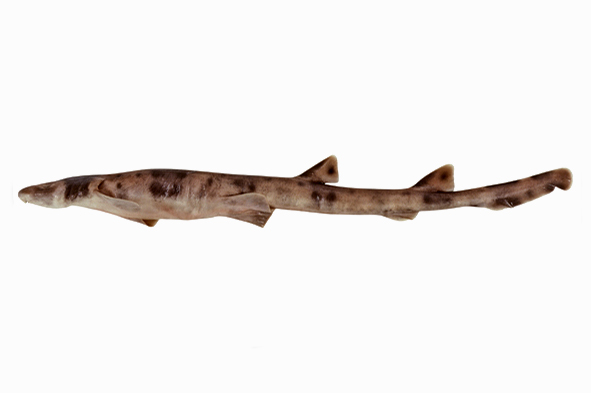Collar Carpetshark, Parascyllium collare Ramsay & Ogilby 1888
Other Names: Collared Carpet Shark, Collared Carpetshark, Collared Cat Shark, Collared Catshark

Collar Carpetshark, Parascyllium collare. Source: Australian National Fish Collection, CSIRO. License: CC By Attribution-NonCommercial
Cite this page as:
Bray, D.J. 2021, Parascyllium collare in Fishes of Australia, accessed 16 Apr 2024, https://fishesofaustralia.net.au/home/species/3287
Collar Carpetshark, Parascyllium collare Ramsay & Ogilby 1888
More Info
|
Distribution |
Mooloolaba, southern Queensland, to Gabo Island, eastern Victoria. Inhabits rocky areas along the continental shelf at depths of 20 to 175 m, possibly to 230 m. |
|
Fisheries |
Taken mainly as bycatch in the Southern and Eastern Scalefish and Shark Fishery. This species is rarely caught in the Queensland East Coast Trawl Fishery. |
|
Species Citation |
Parascyllium collare Ramsay & Ogilby 1888, Proc. Linn. Soc. N.S.W. 2 3(3): 1310. Type locality: off Port Jackson, NSW. |
|
Author |
Bray, D.J. 2021 |
|
Resources |
Catalog of Fishes
|
Collar Carpetshark, Parascyllium collare Ramsay & Ogilby 1888
References
Compagno, L.J.V. 1984. FAO Species Catalogue. Sharks of the World. An annotated and illustrated catalogue of shark species known to date. Hexanchiformes to Lamniformes. FAO Fisheries Synopsis No. 125. Rome : FAO Vol. 4(1) pp. 1-249.
Compagno, L.J.V. 2001. Sharks of the World. An annotated and illustrated catalogue of shark species known to date. Bullhead, mackerel and carpet sharks (Heterodontiformes, Lamniformes and Orectolobiformes). Rome : FAO, FAO Species Catalogue for Fisheries Purposes No. 1 Vol. 2 269 pp.
Compagno, L.J.V., Dando, M. & Fowler, S. 2005. A Field Guide to the Sharks of the World. London : Collins 368 pp.
Compagno, L.J.V. & Niem, V.H. 1998. Families Squatinidae, Heterodontidae, Parascylliidae, Brachaeluridae, Orectolobidae, Hemiscylliidae. pp. 1235-1259 in Carpenter, K.E. & Niem, V.H. (eds). The Living Marine Resources of the Western Central Pacific. FAO Species Identification Guide for Fisheries Purposes. Rome : FAO Vol. 2 687-1396 pp.
Johnson, J.W. 2010. Fishes of the Moreton Bay Marine Park and adjacent continental shelf waters, Queensland, Australia. pp. 299-353 in Davie, P.J.F. & Phillips, J.A. Proceedings of the Thirteenth International Marine Biological Workshop, The Marine Fauna and Flora of Moreton Bay. Memoirs of the Queensland Museum 54(3)
Kyne, P.M. 2010. Chondrichthyans and the Queensland East Coast Trawl Fishery: Bycatch reduction, biology, conservation status and sustainability. PhD thesis, University of Queensland, Brisbane, 361 pp.
Last, P.R., Scott, E.O.G. & Talbot, F.H. 1983. Fishes of Tasmania. Hobart : Tasmanian Fisheries Development Authority 563 pp. figs.
Last, P.R. & Stevens, J.D. 1994. Sharks and Rays of Australia. Canberra : CSIRO Australia 513 pp. 84 pls.
Last, P.R. & Stevens, J.D. 2009. Sharks and Rays of Australia. Collingwood : CSIRO Publishing Australia 2, 550 pp.
Ramsay, E.P. & Ogilby, J.D. 1888. Descriptions of two new Australian fishes. Proceedings of the Linnean Society of New South Wales 2 3(3): 1310-1312
Sherman, C.S. & Heupel, M.R. 2016. Parascyllium collare. The IUCN Red List of Threatened Species 2016: e.T41841A68639742. http://dx.doi.org/10.2305/IUCN.UK.2016-1.RLTS.T41841A68639742.en. Downloaded on 16 January 2018.
Stead, D.G. 1963. Sharks and Rays of Australian Seas. Sydney : Angus & Robertson 211 pp. 63 figs.
Weigmann, S. 2016. Annotated checklist of the living sharks, batoids and chimaeras (Chondrichthyes) of the world, with a focus on biogeographical diversity. Journal of Fish Biology 88(3): 837-1037 See ref online Open access
White, W. 2008. Shark Families Heterodontidae to Pristiophoridae. pp. 32-100 in Gomon, M.F., Bray, D.J. & Kuiter, R.H. (eds). Fishes of Australia's Southern Coast. Sydney : Reed New Holland 928 pp.
Whitley, G.P. 1940. The Fishes of Australia. Part 1. The sharks, rays, devil-fish, and other primitive fishes of Australia and New Zealand. Sydney : Roy. Zool. Soc. N.S.W. 280 pp. 303 figs.


